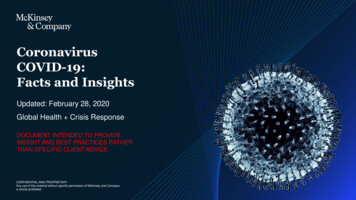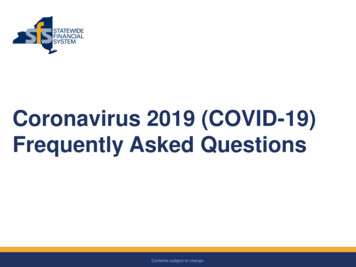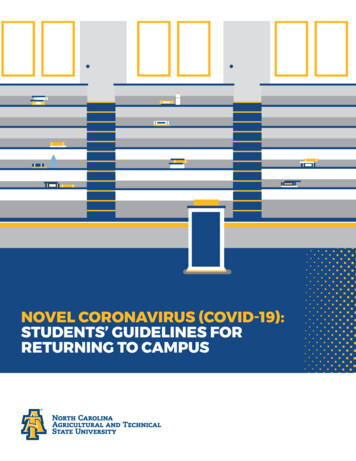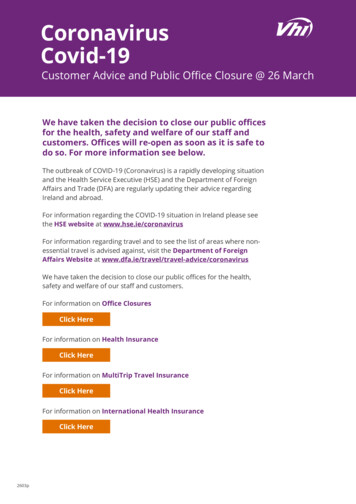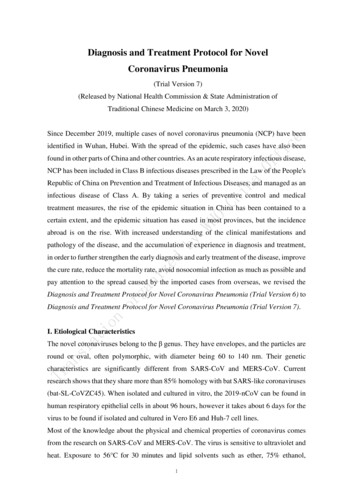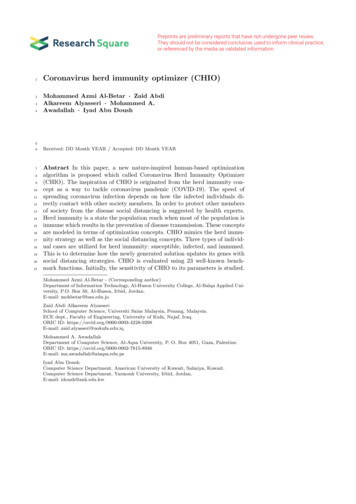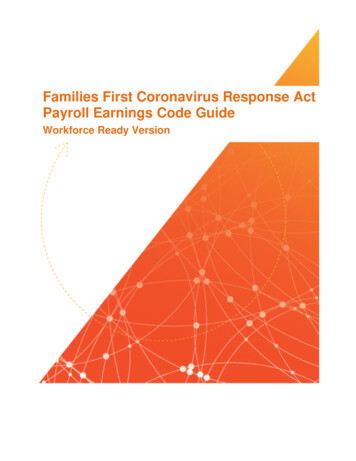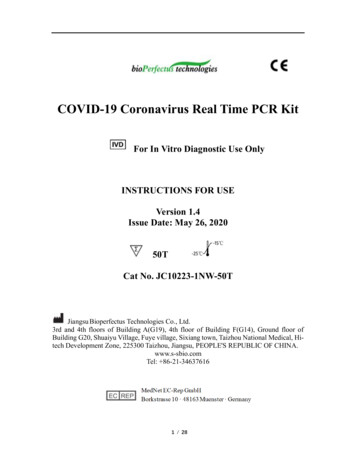
Transcription
COVID-19 Coronavirus Real Time PCR KitFor In Vitro Diagnostic Use OnlyINSTRUCTIONS FOR USEVersion 1.4Issue Date: May 26, 202050TCat No. JC10223-1NW-50TJiangsu Bioperfectus Technologies Co., Ltd.3rd and 4th floors of Building A(G19), 4th floor of Building F(G14), Ground floor ofBuilding G20, Shuaiyu Village, Fuye village, Sixiang town, Taizhou National Medical, Hitech Development Zone, 225300 Taizhou, Jiangsu, PEOPLE'S REPUBLIC OF CHINA.www.s-sbio.comTel: 86-21-346376161 / 28
Contents1.Intended use. 32.Background . 33.Technical principle . 34.Components . 45.Other necessities . 46.Warning and precautions . 57.Kit storage, processing and reliability . 68.Specimen type . 69.Sampling, transportation and storage . 610.Specimen inspection. 711.Reagent preparation . 812. Reagent setup (in reagent preparation area) . 813. Nucleic acid extraction (in specimen preparation area) . 914.Amplification (in amplification area). 1015.Data analysis . 1416.Results interpretation . 1517.Results report . 1618.Quality control . 1719.Limitations . 1720.Performance characteristics . 1821.Reference . 2722.Appendix . 2723.Contact and Support . 282 / 28
1.Intended useCOVID-19 Coronavirus Real Time PCR Kit is an In Vitro Diagnostic (IVD) reagentreplying on fluorescent PCR technology and aiming at qualitatively detect SARS-CoV-2from upper and lower respiratory tract specimens.Upper respiratory tract specimens include throat swab and nasopharyngeal swab. Lowerrespiratory tract specimens include sputum.Sampling objectives include suspected cases infected by SARS-CoV-2, suspected casesdue to crowd gathering, other cases needed to be diagnosed with SARS-CoV-2, and othersuspected environmental and biomaterials (for traceability analysis, for example).Sampling should be carried out by well trained professionals with biosafety andexperimental skills.Typically, SARS-CoV-2 RNA could be detected from upper and lower respiratory tractspecimens if a person is infected. Positive result suggests SARS-CoV-2 infection butbacteria and other virus induced co-infection could not be excluded. SARS-CoV-2 testresult is not the only confirmation evidence of suspected cases and all positive results haveto be reported to Centers for Disease Control (CDCs) and authorities. Negative result canneither straightforwardly exclude SARS-CoV-2 infection and nor the only decision-makingevidence for treatment and patient management. Negative result should be appropriatelyused by combining clinical observation, medical history and epidemiological information.The test is only available to qualified laboratories, certificated clinical PCR laboratoriesand 15189 certificated third-party laboratories with real-time PCR thermal cyclers.Operators carrying out SARS-CoV-2 nucleic acid testing should be well trained withlaboratory biosafety and PCR experimental skills.2.BackgroundOn January 8 2020, the pathogen of severe unexplained viral pneumonia was identified bysequencing as tentatively named the novel (new) coronavirus 2019 (2019-nCoV). OnFebruary 12, 2020, International Committee on Taxonomy of Viruses declared that 2019nCoV was officially named as SARS-CoV-2, and at the same day, World HealthOrganization declared the disease caused by SARS-CoV-2 was officially named ascoronavirus disease 2019 (COVID-19). Till now, about 4.18 million of cases have beenconfirmed in 211 countries and territories such as the USA and southeast Asia, includingsevere and death cases.COVID-19 Coronavirus Real Time PCR Kit is an IVD reagent replying on fluorescent PCRtechnology and aiming at qualitatively detect SARS-CoV-2. The kit containsoligonucleotides primer, double-labeled hydrolysis probe (Taqman) and quality controlsfor PCR reaction.3.Technical principlePrimer and probe are selected from Open Reading Frame gene region (ORF1a/b) and viralnucleocapsid region (N) after the SARS-CoV-2 genome was decoded. The kit designsprimer/probe with specific ORF1a/b gene (labeled by FAM) and N (labeled by VIC) genefor SARS-CoV-2 detection. In addition, the kit also contains human RNase P gene (labeled3 / 28
by CY5) for clinical specimen detection.RNA separated and purified from upper and lower respiratory tract specimens is firstlyundergone reverse transcription to have cDNA, then amplified in real-time PCR thermalcycler. Probes consist of a reporter dye at 5’ and quenching dye at 3’. The fluorescentsignals emitted from reporter dye are absorbed by the quencher, so it doesn’t emit signals.During amplification, probes bonded to templates are cut off by Taq enzyme (5’-3’exonuclease activity), separating reporter dye from the quencher, and generatingfluorescent signals. The PCR instrument will then automatically draw a real-timeamplification curve based on the signal change, and finally realizing the qualitativedetection of SARS-CoV-2 novel coronavirus at the nucleic acid level.4.ComponentsComponentsQuantity VolumeTestRT-PCR Buffer1375 μL50TRT-PCR Enzyme Mix1250 μL50TReaction Mix1200 μL50TPositive Control1500 μL50TBlank Control(RNase-free Water)1500 assiumchloride, Magnesium chloride,Nucleotides mixReverse transcriptase, RNasin,Taq DNA polymerasePrimers and probes of SARSCoV-2 and RNase Pvirus-like particles of SARSCoV-2 and RNase PRNase-free Water5.Other necessitiesExtraction ameCat No.SDK60102Viral nucleic acid isolation SDK60103kitSDK60104SDK60105QIAamp Viral RNA Mini 52904Kit52906Instruments and consumables Vortex mixer Centrifuge Pipette (10μL, 100μL, 200μL, 1000μL) Multi-channel pipette (5-50μL)4 / 28Specification50 T32/48/96 T50/250 T
1.5 mL centrifuge tube shelfMagnetic grate for 1.5 mL centrifuge tubeSpecimen preservation fluid (Vial transfer medium)Real-time PCR thermal cycler: Applied Biosystems 7500 (softwareversion V2.3 and V2.4), QuantStudio 5 (software version V1.4.3 andV1.5.1), Roche LightCycler 480 (software version V1.5.1.62), Bio-RadCFX96 (software version V3.1), Shanghai Hongshi SLAN-96P/S(software version V8.2.2) Nucleic acid extractor:SSNP-2000A (32 channels), SSNP-3000A (64channels), AW-1000 (32 channels) RNase-free Water, molecular grade 10% sodium hypochlorite or Pasteurized disinfectant Disposable particle-free gloves and operating gown Pipette tips with filter 1.5 mL centrifuge tube (No DNase/RNase) 0.2 mL PCR plate (Applied Biosystems) 0.2 mL PCR tube (Applied Biosystems)6.Warning and precautions For in vitro diagnostic use only. Operator should be well trained with real-time PCR techniques. All suspected specimens should be inactivated at 56 for 30 minutes andprocessed in accordance with laboratory biosafety requirements. For irus/2019nCoV/guidelines-clinical-specimens.html Nucleic acid extraction of SARS-CoV-2 should be manually carried out inbiosafety cabinet or by automatic nucleic acid extraction system. Wear personal protective equipment (PPE), including (but not limitedto) disposable clean powder-free gloves, mask, goggles. Working zones in laboratory should be strictly separated. Use separatedand segregated working areas for (i) Reagent preparation, (ii) Specimenpreparation and (iii) Amplification. The workflow in the laboratoryshould proceed in unidirectional manner. The experiment processesshall comply with the Good Clinical Laboratory Practice (GCLP) forMolecular Based Tests Used in Diagnostic 728.pdf Work benches should be cleaned immediately after use. Ampliconcontamination should be avoided according osafety-guidelines.html Clean work benches, pipette and centrifuge by using 10% sodiumhypochlorite and 70% ethanol.5 / 28
The use of sterile disposable pipettes and nuclease-free pipette tips isrecommended.Use applicable real-time PCR instrument and nucleic acid extractionsystem to ensure optimal test performance.Use reagents before expiry date. DON’T replace or interchangereagents from different batches or manufactures.Discard sample and assay waste according to your local t/2003/content 62236.htm7.Kit storage, processing and reliability Store at -20 5oC condition.Always check expiry date before use and do not use expired reagent.Keep probe away from light.Properly unfreeze and mix before reagent preparation.Avoid repeatedly freeze-thaw.Manufacturing date and expiry date: see outer packing box.8.Specimen type Upper respiratory tract specimens: throat swab, nasopharyngeal swab.Lower respiratory tract specimens: sputum.9.Sampling, transportation and storageInappropriate sampling, storage and transportation may lead incorrectdetection results. Following trainings are suggested. Sampling For sampling, please refer to lines-clinical-specimens.html Follow product instructions of instruments and consumables. Swab specimen should be collected using plastic swab withpolypropylene fiber head. Wooden swab with cotton is not suggested.Specimen preserved at virus transport media after collection. Sputum specimen is collected into a 50mL plastic container with viraltransfer medium. A digesting buffer (with 1g/L proteinase K in PBS)was added in the specimen tube at a 1:1 ratio (v/v), mixed with shaking,hold for 5 minutes before the nucleic acid extraction. Collect sputumfrom patient cough and preserve into 50 mL plastic tube with virustransport media. Recommended specimen collection kit.6 / 28
ManufacturerYocon Biotech Co., LtdProduct CodeJing1 viral transfer medium201824002361 plastic swab (sterile)Jiangsu Kangjian MedicalSuApparatus Co., Ltd20180169Health Gene TechnologiesZheCo., Ltd20190062Jiangsu BioperfectusSuTechnologies Co., Ltd20200071Jiangsu BioperfectusSuTechnologies Co., Ltd.20200114Jiangsu BioperfectusTechnologies Co., Ltd.ContentsN/A1 viral transfer medium1 viral transfer medium1 viral transfer medium1 viral transfer mediumPhysical saline containing 0.9%Sodium chloride Transportation Specimen packaging and transportation E-CPI-2019.20/en/ Pack 3 layers according to class A or B infectious articles if externaltransportation involves. Specimen collected from suspected SARS-CoV-2 cases should bepreserved using 2-8 C ice bags or -70 C dry ice and sent to qualifiedlaboratories within 24 hours. Storage Specimen preserves at 2-8 C up to 24 hours after received. Specimen preserves at -70 C or colder if extraction is arranged after 24hours. Extracted RNA preserves at -70 C or colder.10.Specimen inspectionSpecimen should be sent to laboratory as soon as possible and using refrigeratedpreservation if long-distance transportation is inevitable. Transport all specimens within 24 hours to qualified laboratories. Transport frozen specimen using dry ice and unfrozen specimen using ice bag. SARS-CoV-2 viral strain and other infectious biological materials areclassified A corresponding to UN2814. Packaging should follow PI602sub-packaging requirements at International civil aviation organizationdocument Doc9284 “Technical instructions of aviation transport safety ofhazardous articles”. Environmental sample is classified B corresponding7 / 28
to UN3373. Packaging should follow PI650 sub-packaging requirementsat International civil aviation organization document Doc9284 “Technicalinstructions of aviation transport safety of hazardous articles”.Transportation by other ways should refer to abovementioned standards.Please inform receiving laboratory before sending sample.11.Reagent preparation1) Preserve kit at -20 5 C after received.2) Attentions: Use reagent at clean environment and preserve reagent at-20 5 C without light. Avoid repeatedly freeze-thaw.3) Properly dissolve and mix before use.4)Process the RNase-free water and positive reference carefully atspecimen processing zone to avoid contamination. Avoid repeatedlyfreeze-thaw.5)Preserve blank and positive controls at -20 5 C or -70 C .6)Preserve blank and positive controls at -20 5 C or -70 C after extraction.12. Reagent setup (in reagent preparation area)Master Mix and reaction well settingNote: Setting of reaction wells varies with sample quantity. Each run shouldcontain blank and positive controls.1) Unfreeze RT-PCR buffer, enzyme mix and reaction mix from -20 5 Cat reagent preparation zone.2) Dissolve RT-PCR buffer, enzyme mix and reaction mix properlybefore use.3) Repeatedly upside down 5 times to mix.4) Centrifuge 5 s.5) Label a 1.5 mL centrifuge tube.6) Double check reaction quantity (N), including sample quantity (n) to betested, blank and positive control quantity (overdose is accepted). Preparemaster mix based on below table.StepVolumeComponents1RT-PCR BufferN 7.5 µL2RT-PCR Enzyme MixN 5.0 µL3Reaction MixN 4.0 µL4RNase-free waterN 3.5 µLTotalN 20.0 µL If sample quantity (n) including quality control is between 1 14,N n 1.8 / 28
If sample quantity (n) including quality control 15, N n 2.7) Preserve above master mix into the labeled 1.5 mL centrifuge tube andmix.8) Centrifuge 5 s.9) Place PCR reaction tube or plate into 96-well shelf.10) Pipette master mix to each reaction well 20 µL.11) Tightly close the PCR reaction well/plate and transfer to the nucleic acidprocessing zone.13. Nucleic acid extraction (in specimen preparation area)Instruments preparationClean all work benches, pipettes, centrifuge and other instruments using 5% sodiumhypochlorite and 70% ethanol.Nucleic acid extractionPerformance of COVID-19 Coronavirus Real Time PCR Kit depends on thequantity and purity of nucleic acid extraction. Below listed extraction kits have beenexperimentally verified and could be used for SARS-CoV-2 RNA extraction.Bioperfectus Viral Nucleic Acid Isolation KitSDK60102, spin columnSDK60103, magnetic beads (manually)SDK60104, magnetic beads (auto)SDK60105, magnetic beads (auto)Qiagen QIAamp Viral RNA Mini Kit52904/52906, spin columnExtraction follows instructions from kit manufacturer.Blank and positive controls should fully involve nucleic acid extraction process.Add template1)2)3)4)5)6)7)Tenderly vortex mix centrifuge tube containing purified RNA 5 s.Centrifuge 5 s to sediment purified RNA.Add 5µL RNA to each well.Close the cap after adding 8 wells.Continue the work to avoid contamination.Wear gloves to avoid contamination.Close all caps after the job and transfer to positive control processingzone.Add quality control1) Add 5 µL blank control to reaction well and close the cap.2) Add 5 µL positive control to reaction well and close the cap.Note: please follow the sequence from 1 to 8 if using 8-tue strips.9 / 28
3) Centrifuge the 8-tube strip 10-15 s and then place back to the shelf.Note: centrifuge 30 s with 1000 rpm/min if using PCR 96-well plate.14.Amplification (in amplification area)Run the experiment in Applied Biosystems QuantStudio 5 real-time thermal cycler.Setup1) Double click Applied Biosystems QuantStudio 5 icon, and runApplied Biosystems QuantStudio 5 real-time thermal cycler.2) Choose “create new files” on the window.3) Set the following items from the “Properties” menu.a. Instrument type:b. Block type:c. Experiment type:d. Chemistry:e. Run mode:4) Click “Next” at the bottom.Program setting1)Choose “Method” in the menu.2)Modify thermal cycling conditions as follows.a. Set 50 C, 10 min, 1 cycle at “Hold stage” step 1.b. Set 97 C, 1 min, 1 cycle at “Hold stage” step 2.c. Set 97 C, 5s at “PCR stage” step 1.d. Set 58 C, 30s at “PCR stage” step 2.e. Fluorescent detection at 58 C, “PCR stage” step 2.f. Set cycle number 45.10 / 28
g. Modify “Volume” to 25 µL.3)Click “Next” at the bottom.Target setting1)Choose “Plate” from the menu and then show “Quick setup”.2)Choose “None” at “Passive reference”.3)Click “Advanced setup” to set targets. Define luminophore and quencher foreach probe and then analyze each primer/probe after the reaction.4)Create ORF1ab Target includinga. Name: ORF1abb. Reporter: FAMc. Quencher: NoneColor: do the following to modify the color of the target11 / 28
Click color block to show the list.Click the block to define a color.Click “apply” to return to “Target” window.5)Create N Target includinga. Name: Nb. Reporter: VICc. Quencher: NoneColor: do the following to modify the color of the targetClick color block to show the list.Click the block to define a color.Click “apply” to return to “Target” window.6)Create RNase P Target includinga. Name: RNase Pb. Reporter: CY5c. Quencher: NoneColor: do the following to modify the color of the targetClick color block to show the list.Click the block to define a color.Click “apply” to return to “Target” window.7)Choose well position from the right “View” window and then check thetarget in the left.Sample setting1) Click “Add” from “Sample” window and set samples.2)Create Sample 1 includinga. Defaulted sample name “Sample 1” and is adjustable.Color: do the following to modify the color of the sampleClick color block to show the list.Click the block to define a color.12 / 28
Click “apply” to return to “Sample” window.b. Choose well position from the right “View” windowand then check the sample in the left.3)Click “Next”.Run the program1) Ensure program setting is correct and then mount the PCR plate to theinstrument.2) Click “START RUN” from “Run” menu.3) File has to be saved before running. Click “File” from main menu and thenchoose “Save as”. Save in an appropriate folder.4) Click “Start”. It takes around 72 min.13 / 28
15.Data analysis1) After amplification, click “Results”.2) Choose “Amplification Plot” to view the data.14 / 28
16.Results interpretationExpected performance of COVID-19 Coronavirus Real Time PCR Kit quality controls.QualitycontrolsNameUsed forORF1abNRNsae PPositivecontrolPTCFailure of kit orexperiment ExpectedCtCt 30NotdetectedInternal control RNase P gene monitors sampling and extraction processes andpotential contamination of extraction process.If any of above controls shows incorrect Ct value, it is suggested that the testing isincorrect or re
Technologies Co., Ltd Su 20200071 1 viral transfer medium Jiangsu Bioperfectus Technologies Co., Ltd. Su 20200114 1 viral transfer medium Jiangsu Bioperfectus Technologies Co., Ltd. N/A Physical saline containing 0.9% Sodium chloride Transportation Speci
